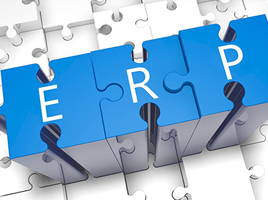Software companies around the globe are racing to get a better foothold in the Software as a Service space with regards to both Enterprise Resource Planning and Customer Relation Management software.
In the latest report from Gartner, the CRM area grew some 14% between 2012 and 2013, from $18 billion to $20.4 billion. Gartner also points out that 41% of CRM systems sold were based on SaaS and that growth in the ERP sector was better in 2013 than in 2012, at just under 4%.
The interesting portion of this is that over 40% of these two sectors were sold as SaaS packages. Salesforce.com (NYSE:CRM) is the dominant player in the CRM market, while SAP AG (NYSE: SAP) has been the dominant player in the ERP market.

ERP and CRM software companies are rapidly moving into the SaaS atmosphere, which also changes the revenue model for companies such as SAP, Oracle Corporation (NYSE: ORCL) and even Microsoft Corporation (NYSE: MSFT) who in the past have relied on perpetual licenses as well as annual maintenance fees.
SaaS relies on annual subscriptions, which leads to recurring turnover with clients year over year. There are other players in this brutal competition for dominance and market share but for now let’s just concentrate on the current state of these four companies.
Where do they all stand and where are they going?
Oracle Corporation had very little growth in the CRM space in 2013 at only 4%, but the company still retained third spot in the CRM space with at 10% of total market share.
Oracle is also number two in the ERP market with just over 12% of the market but here again achieved little to no growth in 2013 in the ERP sector.
Oracle remains head and shoulders above the rest in data management and also offers upside with SaaS delivery of software packages. Oracle has also been instrumental in integrating acquisitions to spur their revenue growth. During 2013, Oracle acquired eight separate operators and has also acquired two additional companies so far in 2014.
These acquisitions have been directly implemented to bolster not only Oracle’s overall product line but to help facilitate the need for their Cloud and SaaS vision. Currently Oracle has a forward price to earnings of 13.22 at current share prices and has forecast quarterly revenue growth of 3.90% for 2014. Oracle is also offering a yearly dividend of $0.48, which translate to a 1.10% yield.
Microsoft Corporation had a growth rate close to 23% in CRM software and little to no growth in the ERP market in 2013.
Overall Microsoft has cornered 7% of the CRM market and 5% of the ERP market. Microsoft has made strides in the SaaS world based on its ability to leverage their line of products through the use of their Cloud services. Microsoft Office has been a cash cow for the company for many years and Microsoft Office365 is no different – adding some 4.4 million subscribers to this SaaS since its inception. Microsoft also continues to grow its commercial Cloud business with Azure growing 150% in just the last quarter.
Microsoft is also making more headwinds in the mobile space after its purchase of certain parts of Nokia as well as with the new Surface tablet/laptop hybrid which showed a 50% increase in sales in the most recent quarter. With Satya Nadella taking the reins as CEO, Microsoft is on the verge of innovating new technology again along with bolstering its current product line. Microsoft is currently trading at a forward price to earnings of 13.92 and also offers a handsome $1.12 yearly dividend, which translate to a 2.8% yield at current share prices.
SAP AG had a growth rate of almost 13% in 2013 with regards to CRM and a minuscule growth rate in ERP market for the last year. SAP is still the overall leader in ERP with over 24% of the market share and is currently second in the CRM space with just over 13% of market share.
SAP reported a 3% increase in net profit during their last quarter bolstered by a 60% increase in Cloud services and a small 3% increase in business software. But overall software revenue was down in the last reported quarter from a year ago while quarterly revenue growth is seen to be around 2.70% year over year.
SAP has also invested in many acquisitions, including deals with Oracle and Microsoft to bolster its SaaS and Cloud services. A strong euro could dampen things at SAP as currency hedges by the company may not be able to keep pace. SAP shares are currently trading at a forward price to earnings of 13.92 as well as offering a nice dividend of $0.99 which is about a 1.30% yield.
Salesforce.com was the fastest growing CRM provider in 2013 growing at a rate of over 30% and had the highest quarterly revenue growth rate year over year at almost 38%, but the company has yet to turn a profit.
The company also has an astronomical forward price to earnings number of 74.36. But Salesforce.com has continued to grab market share from all of the above mentioned companies and is the first Cloud company to be listed by Gartner on their top 10 worldwide list for software.
Salesforce.com also had the highest revenue growth in Gartner’s top list for software. CEO Marc Benoiff is a master at developing new products and is always on the cutting edge of technological advances.
Salesforce.com may run into trouble as other companies like Oracle and SAP develop new forms of multitenancy which allows Salesforce.com customers to share an application but keeps the customers’ information separate.
With over 41% of all software sold as SaaS in 2013, the competition for Salesforce.com will increase as hybrids of multitenancy makes it easier for users to install “plug ins” for specialized software.
Outlook
Overall, the outlook for SaaS and these four companies looks bright for medium and long term investors. Pressure will be put on Salesforce.com to innovate, and pressure will be put on Microsoft, Oracle, and SAP to rise to the challenge.
Don’t be surprised if Oracle with over $40 billion in reserve, and Microsoft with over $50 billion, start to buy up even more of the competition. Salesforce.com and SAP don’t have the ready cash available to combat the other two if consolidation starts to take place in the sector.
But SAP does have a working relationship with Microsoft. Salesforce.com might be forced to align themselves in strategic areas with rivals like IBM (NYSE: IBM) or Hewlett Packard (NYSE:HPQ) to fight off the competition posed by Oracle and Microsoft if hybrid multitenancy becomes a real threat.










